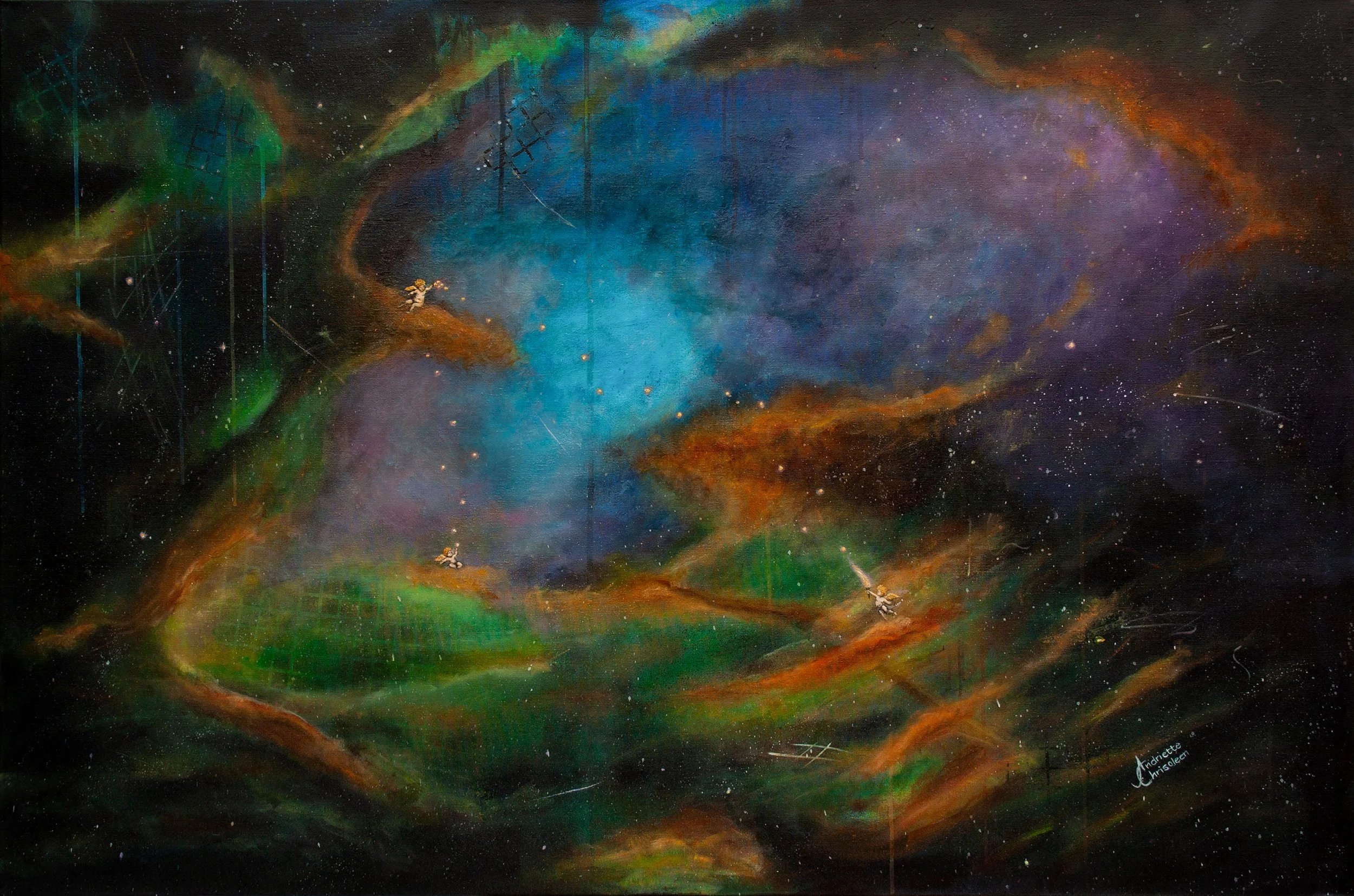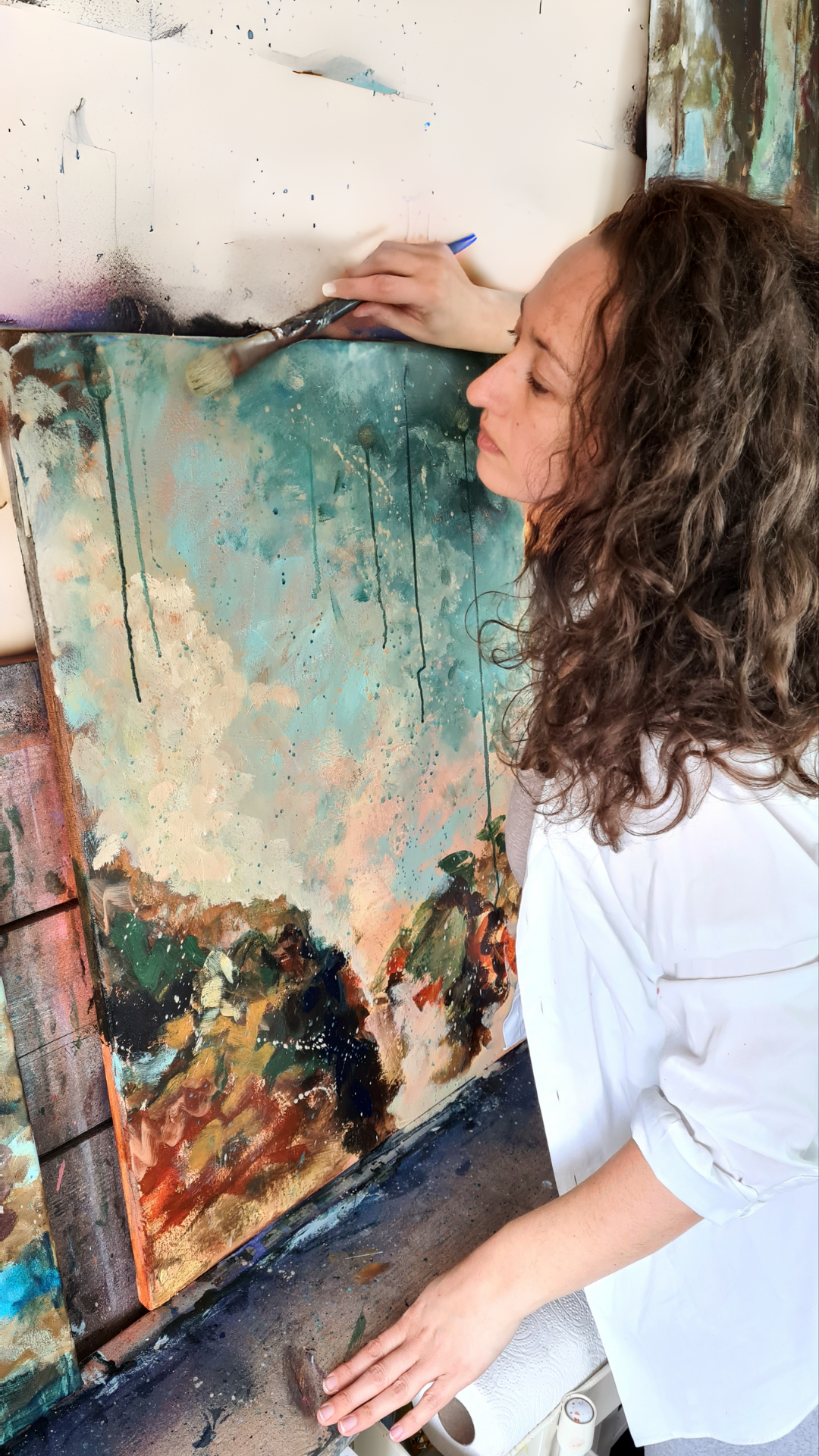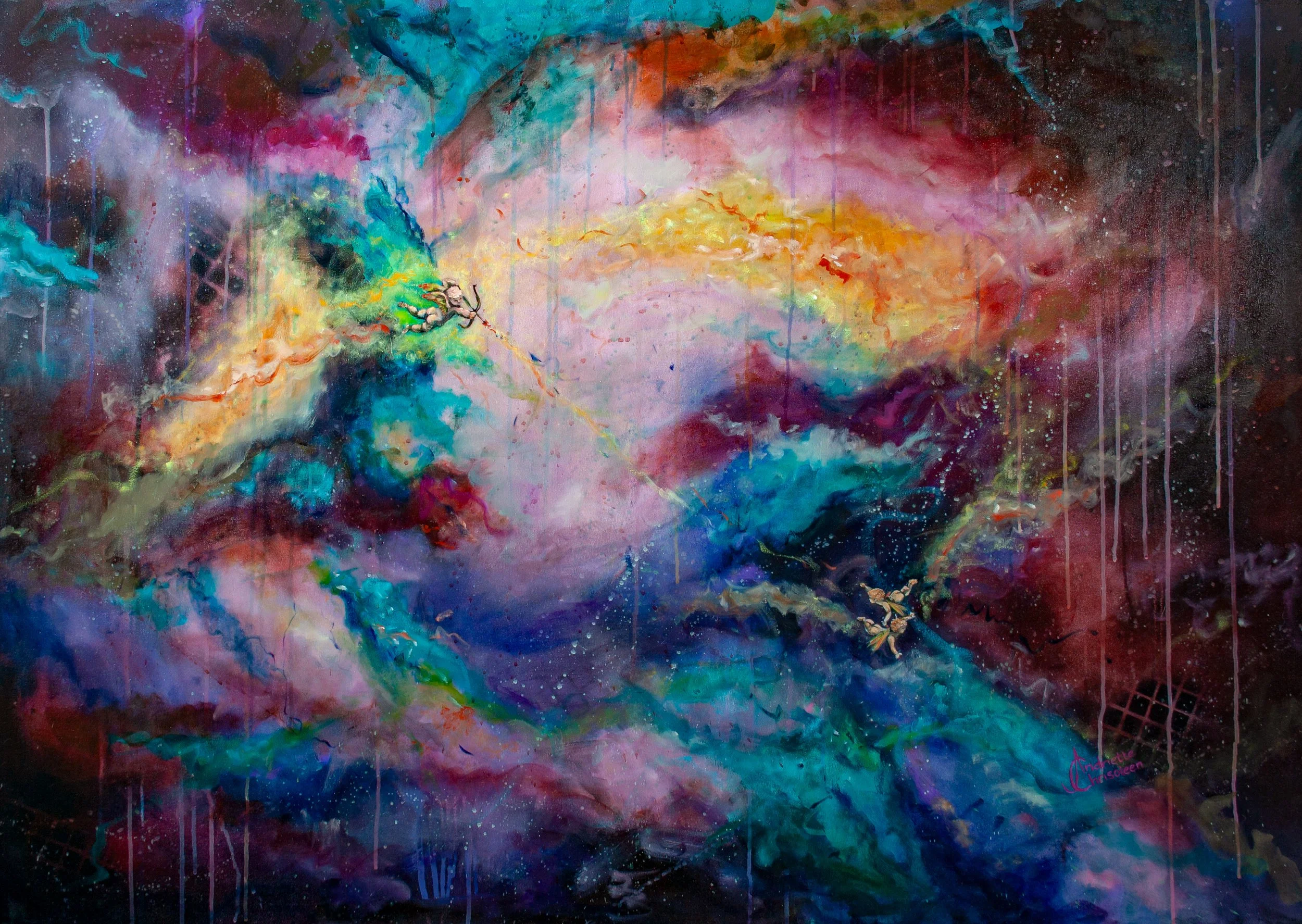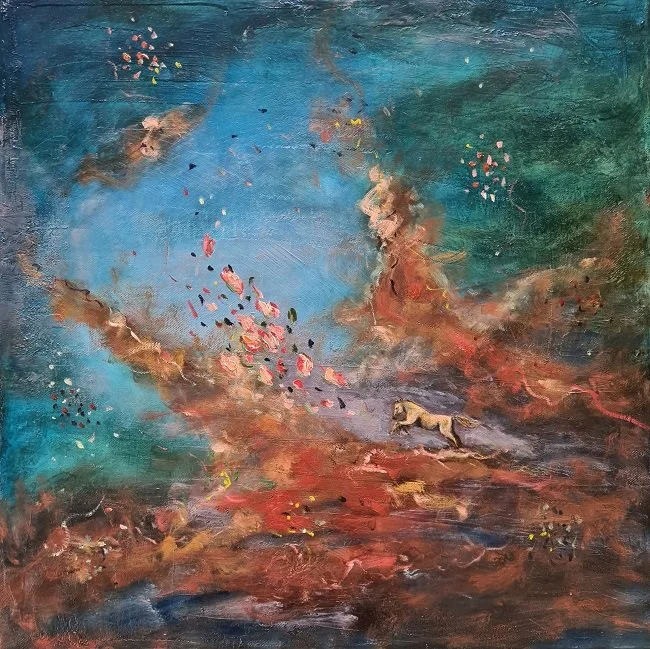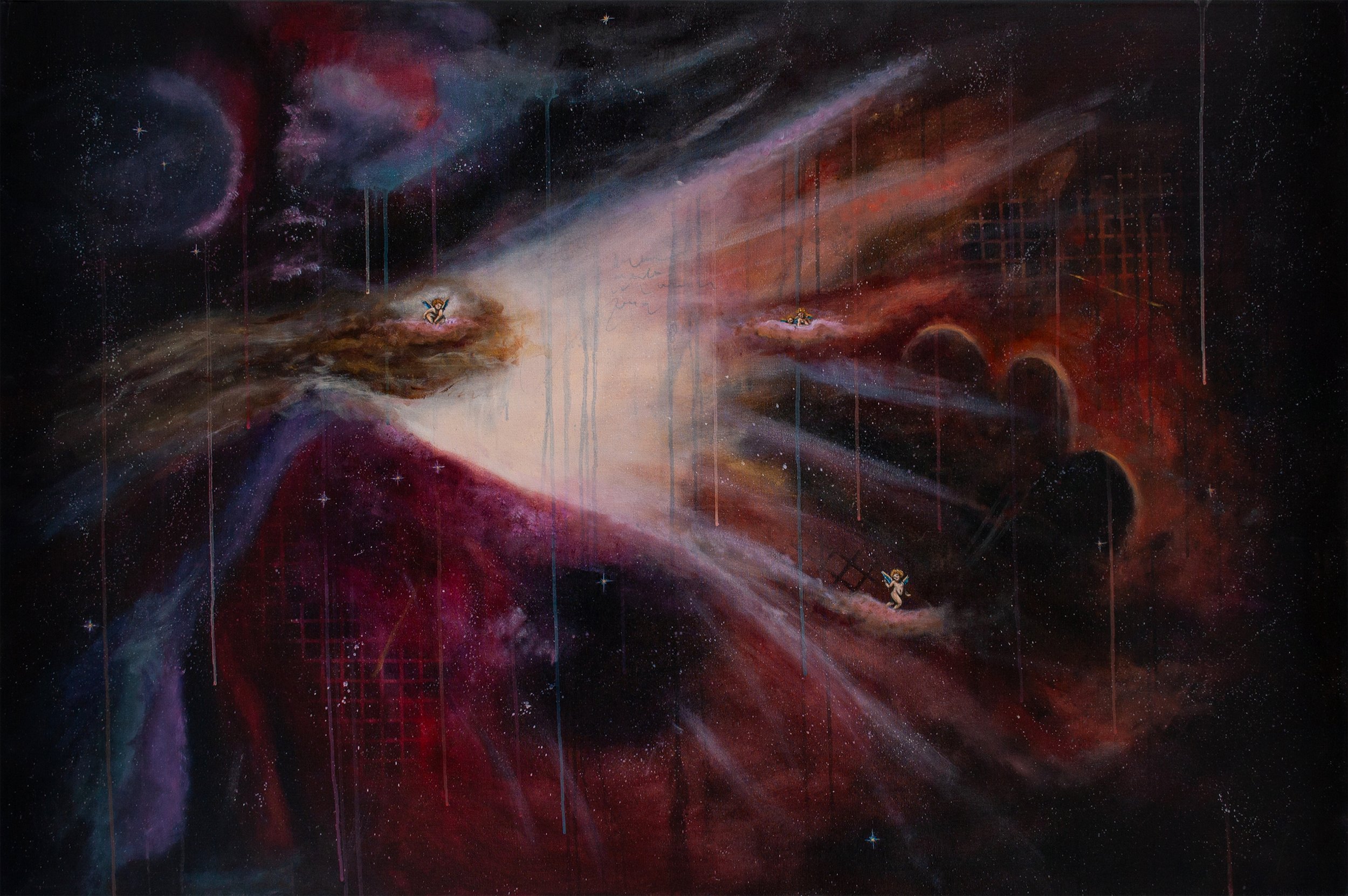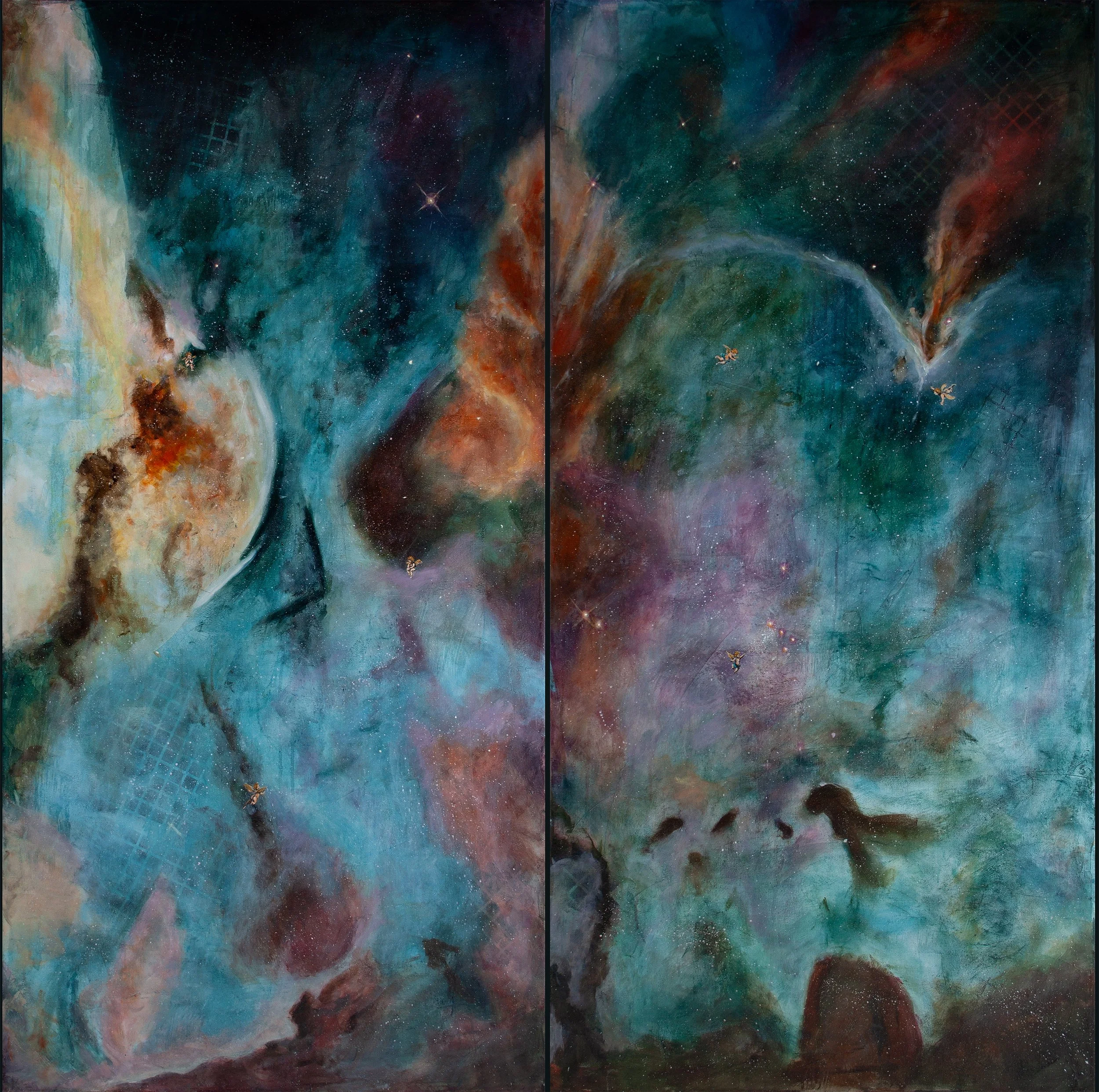Interview with Andriette Chrisoleen
Andriette Chrisoleen is an artist whose work blends imagination with reality to create ethereal worlds on canvas. Her art offers a colorful escape from the everyday hustle, inviting viewers to explore vibrant dreamscapes filled with hidden details and surprises. Inspired by the natural beauty and cosmic wonders she has encountered in her travels through Europe, the USA, and Africa, Andriette creates paintings that are both visually stunning and emotionally impactful.
A pivotal sabbatical from her office job helped Andriette reconnect with her passion for art, leading her to complete the Mastery Program at the Milan Art Institute. This transformative experience refined her unique artistic voice. Now, her work features vibrant colors, rich textures, and hidden elements that invite viewers to discover something new with every look. Her slogan, “Ethereal Worlds on Canvas: Imagination for the Soul,” perfectly captures the essence of her creations.
"My art is a journey into the vastness of imagination, blending the freedom of open landscapes with the mystery of the cosmos. Each piece I create is an invitation to step away from the rush of daily life and into a world of wonder and tranquility. I start with inspiration from the galaxy, scenic views, and underwater landscapes, using acrylics, modeling paste, and mixed media to build vibrant, textured backgrounds. Hidden within these abstract forms are tiny, realistic elements, adding a layer of discovery and magic. My goal is to offer viewers a moment of luxury and escape, encouraging them to explore both the beauty of the world around us and the depths of their own inner landscapes."
Your artwork often draws inspiration from both nature and the cosmos. Can you elaborate on how specific elements like landscapes, celestial bodies, or natural phenomena influence your creative process? How do you translate these vast and varied sources of inspiration into your abstract canvases, and what kind of emotional or intellectual responses do you hope to evoke in your viewers?
Nature and the cosmos are endless sources of inspiration for me. Whether it’s the vastness of a starry sky, the quiet beauty of a mountain range, or the mysterious depths of the ocean, these elements speak to me on a deep level. When I paint, I’m not just trying to replicate what I see—I’m more interested in capturing the feeling those scenes evoke.
My process starts with absorbing these elements, letting them stir something inside me. I often think about how the universe, with all its mystery and beauty, parallels our inner landscapes. This connection between the outer world and our inner feelings is something I try to bring onto the canvas.
As I paint, I aim to create a space where viewers can lose themselves, much like how I feel when I’m out in nature or gazing up at the stars. I want them to feel a sense of peace, wonder, and maybe even a little curiosity—like there’s something just beyond what they can see, waiting to be discovered.
The concept of art as an escape is central to your work, creating a portal to a calm, luxurious dream world. Can you describe the specific techniques and artistic choices you make to construct these dreamlike scenes? What do you believe it is about your use of color, form, and texture that allows your paintings to provide such a profound sense of tranquility and escape?
When I create, it feels like stepping into another realm, where the boundaries between reality and imagination blur. My process is less about following a set of techniques and more about embracing the freedom to explore what lies beyond the surface. Each painting begins with a sense of letting go, allowing the colors and forms to guide me as if they have a life of their own.
The textures and layers in my work emerge almost instinctively, as though they’re revealing themselves to me rather than the other way around. There’s a deep sense of connection to the elements—like the way the wind shapes a landscape or the stars map out the cosmos. I tap into this feeling, letting it flow through me and onto the canvas, where it takes shape in ways that surprise even me.
The vibrant colors and soft, organic forms in my paintings are not just chosen; they are felt. They come from a place of deep emotion, where tranquility and wonder coexist. It’s as if the canvas becomes a portal, drawing the viewer into a space where they can find peace and escape from the noise of the world.
The small, hidden details—those tiny, realistic touches—are like whispers from another world, inviting you to look closer and discover the magic that lies just beneath the surface. They’re reminders that even in the abstract, there is something tangible and real, waiting to be found.
In the end, the process is a mysterious journey, one that unfolds with each brushstroke and each layer of paint. It’s about creating a space where the viewer can lose themselves, find something new, and feel the quiet luxury of imagination at work.
After taking a break from your office job and rediscovering your passion for art, you returned with a fresh perspective that deeply influenced your artistic vision. Can you share some specific experiences or places from your travels that had the most significant impact on your creativity? How are these influences reflected in your current work, and in what ways did they help you develop new ideas and techniques?
Taking a break from my office job was a pivotal moment for me. It allowed me to reconnect with my love for art and to explore it in a way I hadn’t before. During this time, I traveled through Europe, the USA, and Africa, and each place left its mark on my creativity.
One of the most impactful experiences was in South Africa, where I spent time with my family. My cousin and I once lay on the grass in my aunt’s backyard, staring up at the galaxy. He showed me the Milky Way, and we spent hours talking about the stars and the universe. The next day, we visited an observatory in Cape Town, which deepened my fascination with the cosmos. This experience continues to influence my work, especially in how I depict space and the feeling of vastness.
These travels also taught me to see beauty in the details—whether it’s a delicate flower in a European garden or the powerful presence of a lion in the African savannah. These experiences are reflected in the tiny, hidden elements I often include in my paintings, inviting viewers to discover something new each time they look.
You mention that mixing realism into your abstract work keeps the viewer guessing. How do you decide which realistic elements to incorporate into your abstract pieces, and what challenges do you face in balancing these two contrasting styles? What kind of reactions or interpretations do you aim to evoke from your audience with this unique blend of realism and abstraction?
Incorporating realism into my abstract work is all about creating a sense of discovery and wonder. I love the idea of drawing viewers in with vibrant colors and abstract forms, only to surprise them with tiny, realistic details they might not notice at first glance. It’s like leaving little treasures hidden within the canvas, waiting to be found.
When deciding which realistic elements to include, I let the painting guide me. Sometimes it’s a cherub peeking through the clouds or a delicate flower floating amidst a swirl of colors. These elements often emerge naturally as I work, almost like they belong there all along.
The biggest challenge is finding the right balance between the abstract and the real. I want the realism to enhance the abstract, not overpower it. It’s about creating harmony between these two worlds—where the abstract sets the stage and the realistic touches add depth and meaning.
The reactions I aim to evoke are curiosity and delight. I want viewers to feel like they’ve stumbled upon something special, something that invites them to look closer and spend more time with the painting. It’s all about engaging their imagination, encouraging them to see beyond the surface and explore the hidden stories within the art.
Ultimately, my goal is for the viewer to walk away with a sense of wonder and a feeling that they’ve experienced something unique—something that’s as much about what’s seen as what’s felt.
Your transition from realistic wildlife and portraits to your signature abstract style with a touch of realism is quite fascinating. What motivated this significant shift in your artistic approach, and how has this transition affected the way you perceive and create art? Can you discuss any specific challenges you faced during this transition and how you overcame them?
I loved painting realistic wildlife and portraits—it’s incredibly rewarding to capture the fine details and bring a subject to life. But over time, I started feeling like something was missing. I wanted to express more of what was in my mind and heart, not just what I saw in front of me. I was craving the freedom to create something entirely my own, to dive into my imagination and let that lead the way.
The transition to a more abstract style was a journey of self-discovery. It wasn’t always easy, especially when I was so used to working within the boundaries of realism. The biggest challenge was letting go of control and allowing my intuition to guide me. I had to learn to trust the process and embrace the unpredictability of abstract art.
Overcoming these challenges meant reminding myself why I started creating in the first place—this deep need to express something beyond the visible, to connect with others on a different level. It’s been a liberating experience, and now, I feel like my art truly reflects who I am and what I want to share with the world.
Your time at the Milan Art Institute's Mastery Program was a transformative period for you as an artist. What were some of the key lessons or experiences from this program that helped you find your true abstract voice? How did the program influence your artistic philosophy and technical skills, and in what ways has it impacted the direction of your work since graduating?
The Mastery Program at the Milan Art Institute was a game-changer for me. It helped me find my true abstract voice by pushing me to explore my creativity in ways I hadn’t before. One of the key lessons was the importance of storytelling in art—how to convey a narrative or emotion even in abstract forms. This really resonated with me and shaped the way I approach my work now.
The program also taught me to embrace different techniques and materials, which was crucial in developing the layered, textured style that’s now a signature of my work. It wasn’t just about learning how to paint but understanding why I paint and what I want to say through my art.
Since graduating, the direction of my work has been profoundly impacted. I feel more confident in my style and my ability to convey the sense of freedom and imagination that is central to my art.
Your art often celebrates the unseen and the enchanting, drawing from ancient myths and the mysteries of the natural universe. How do you go about selecting the themes and stories you want to explore in your paintings? Can you provide examples of specific myths or natural mysteries that have inspired particular pieces, and explain how you weave these elements into your art?
I’m drawn to ancient myths and the mysteries of the natural universe because they carry a sense of the unknown—something elusive and magical. I love the idea of unraveling secrets and finding hidden gems in nature, then bringing those discoveries to life in my art.
When selecting themes, I look for stories that resonate with that sense of mystery and enchantment. For example, I’m fascinated by the myth of cherubs guarding the Garden of Eden—a hidden, protected paradise. This idea often finds its way into my work, where I’ll include tiny cherubs hidden within abstract forms, symbolizing a secret world waiting to be discovered.
The Milky Way, with its vastness and beauty, is another recurring theme. Inspired by my time in South Africa, I often depict swirling patterns and luminous colors that evoke the galaxy. Hidden within these forms, you might find small, realistic details like a cherub or a flower, inviting viewers to look closer and uncover the stories woven into the painting.
My goal is to create art that feels like a treasure hunt, where each detail, color, and form invites you to explore deeper, both in the painting and within yourself.
Your distinctive use of mixed media and oil paint to create dreamlike scenes involves a complex technical process. Can you walk us through this process, from the initial concept and planning stages to the application of the final layers of oil? How do you decide which materials and techniques to use at each stage, and what do you find most rewarding about working with these diverse media?
Creating my dreamlike scenes involves a detailed and immersive process that begins with gathering inspiration from a variety of sources. I look at pictures of the galaxy, scenic views, and underwater environments. I also travel, visit observatories, and spend time in nature with my dog to soak in the beauty and vastness of the natural world. These experiences fuel my imagination and help me form a clear vision for my artwork.
Once I have my inspiration, I develop concepts, color stories, and compositions. I often create studies on paper or use Photoshop to refine my ideas. This planning phase helps me visualize the flow and harmony of the piece. However, when the ideas are very clear, I sometimes start directly on the canvas.
In the early stages of a painting, I love the feeling of freedom and letting go of control. I begin with acrylics for the base layers because they allow me to build up initial textures and colors quickly. Acrylics provide a solid foundation on which I can experiment with different elements. I then use modeling paste to add extra structure and depth to the piece. Spray paints and markers come into play for adding dynamic, spontaneous elements that keep the composition lively and interesting.
To see my work from different perspectives, I take lots of pictures and use mirrors. This technique often sparks new ideas and helps refine the composition.
Occasionally, I incorporate collage and gold leaf to introduce new textures and visual effects. These materials add an element of surprise and luxury to the work, enhancing its overall richness.
The final and most rewarding stage involves applying oil paints. Oils provide a depth and vibrancy that other mediums can't match. They allow me to create subtle gradients and intricate details, adding that touch of luxury and refinement to the painting. The oil layers bring the piece to life, offering a sense of depth and dimensionality that invites viewers to get lost in the scene.
Each stage of the process is carefully considered to enhance the final composition. The combination of different materials and techniques allows me to create complex, layered works that invite viewers to explore and discover new details. The depth and richness that oil paints add are particularly satisfying, as they bring a sense of completeness and luxury to the artwork.
As a member of Kunst in Pijnacker-Nootdorp (KiP), you actively engage with and contribute to the artistic community. How does this involvement influence your work and creative collaborations? Can you share some examples of how participating in KiP has led to new ideas, projects, or artistic growth for you, and what you believe is the importance of such community engagement for artists?
Being part of Kunst in Pijnacker-Nootdorp (KiP) has been incredibly enriching for me. The network of artists in our community is not only supportive but also inspiring. We share ideas, ask questions, and push each other to explore new creative directions. While I’m still relatively new to the group, I already feel the positive impact of being surrounded by like-minded artists who are passionate about their work.
One of the most valuable aspects of KiP is the opportunity to get involved in promoting art and culture in our local area. We’re all dedicated to increasing exposure for the arts where we live, which is something I believe is so important—not just for artists, but for the community as a whole. Art has a way of bringing people together and enriching our daily lives.
I’m also excited about the potential for future collaborations within KiP, like joint exhibitions or even creating artworks together. Being part of this community challenges me to think outside of my usual methods and helps me grow as an artist. Engaging with others in this way fosters a sense of belonging and mutual support, which is essential for continuous learning and creative growth.
You describe your art as an open door to discovery and a mirror reflecting the beauty of the world and ourselves. How do you hope your work encourages viewers to explore both their external surroundings and their inner landscapes? Can you discuss any specific techniques or themes you use to invite this deeper level of reflection and discovery, and what feedback or responses you have received from viewers that suggest your work is achieving this goal?
My art is all about creating a space where viewers can explore both the beauty around them and the emotions within them. I love the idea of art as a journey—where each color, texture, and hidden detail invites you to go deeper, to discover something new, not just in the painting but in yourself.
I use a combination of abstract forms and tiny, realistic elements to create this sense of discovery. The abstract forms capture the imagination, pulling viewers into a dreamlike world. Then, as they get closer, they start to notice the smaller, hidden details—like a cherub tucked away in a cloud or a delicate flower floating in a swirl of color. These little surprises are like whispers from another world, encouraging viewers to take their time and explore every inch of the canvas.
The themes of nature and the cosmos are central to my work because they represent both the vastness of the universe and the intimate connection we have with it. I hope that when people look at my paintings, they feel a sense of peace and wonder—a reminder that there’s so much beauty to be found, both out there in the world and within ourselves.
I’ve had viewers tell me that they find something new every time they look at one of my pieces, which is exactly what I aim for. Knowing that my art can offer someone a moment of escape, reflection, or even just a sense of calm, means the world to me. It’s all about creating that connection, where the viewer feels like they’ve not just seen something beautiful, but experienced something meaningful.
https://andriettechrisoleen.com
https://www.instagram.com/andriettechrisoleen/



